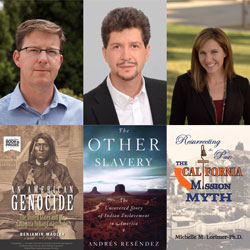Sadly, there is no known photograph of Dame Shirley extant. The California Historical Society Collection, however, includes stunning daguerreotype photographs documenting the cities, towns, and people of the California Gold Rush. Reproductions of some of these photographs are now on exhibit at the Opera House lobby—along with artifacts from the Collections of Levi Stauss & Co., the Museum of Performance + Design, and the Society of California Pioneers—through December 10th. Selections are presented below.
 |
Rosalía
Vallejo de Leese, after 1847, photographer unknown, daguerreotype,
courtesy, California Historical Society
|
Women were not only the subjects of early California daguerreotype portraits, they were also photographers. According to photography historian Peter Palmquist, Rosalía’s niece Epifania "Fannie" de Guadalupe Vallejo may have been California's first photographer, acquiring a daguerreotype camera around 1847.
 |
San Francisco
panorama [fifth panel], spring 1851, photographer unknown, daguerreotype,
courtesy, California Historical Society
|
Although photographers flocked to California during the Gold Rush, the California Historical Society’s seven-plate panorama is one of only six surviving daguerreotype panoramas of San Francisco. Standing on sand dunes now at the corner of First and Howard Streets, the unknown photographer captured a vivid urban tableau, from the clapboard houses of Happy Valley to the shipbuilding works at Rincon Point. A washerwoman can be spied in the fifth panel (shown above), sitting in the doorway of her shack as laundry flutters in the spring breeze.
 |
Group
of miners, circa 1850s, photographer unknown, daguerreotype,
courtesy, California Historical Society
|
This full-plate portrait of a group of Gold Rush miners is
one of the most spectacular and moving daguerreotypes in the California
Historical Society Collection. Nine miners, perhaps forming a company, pose
together in various attitudes of affection, insouciance, and camaraderie. Four of
the men proudly display the tools of their trade, a shovel, pick, sluice box,
and claim.
 |
|
Diamond
Springs, El Dorado County, 1854, photographer unknown,
daguerreotype, courtesy, California Historical Society
|
This daguerreotype of a street scene in Diamond Springs
captures the look and feel of a young Gold Rush town. In addition to the
offices of the Advocate newspaper and
Wells Fargo & Co., many charming details are visible, including a broadside
for a theatrical performance by the Bateman children. Eleven figures paused to
pose for the shot; only one (to the left, leaning against a post) failed to
remove his hat.
Marie Silva, Archivist & Manuscripts Librarian








